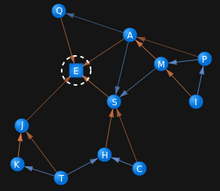Routing Protocol for Low Power and Lossy Networks
Routing Protocol for Low Power and Lossy Networks ( RPL ) [ rip′əl ] ( German routing protocol for low-power and lossy networks ) is an Internet routing protocol that is specially optimized for wireless sensor networks and is specified by the IETF . The protocol is no longer specified for IPv4 , but only for IPv6 .
Emergence
When the IETF working group ROLL (Routing Over LoW power Lossy Networks) analyzed existing routing protocols such as OSPF , IS-IS , AODV and OLSR , it found that these protocols in their current form did not meet the requirements for a routing protocol for sensor networks .
So the IETF began developing a new routing protocol called "RPL". The design of RPL is closely related to the development of 6LoWPAN .
RPL is specified in RFC 6550 . Other important specifications of the ROLL group are the trickle algorithm ( RFC 6206 ) for the timing of the information packets, routing metrics ( RFC 6551 ), and the objective function zero ( RFC 6552 ), which is required for the selection of the preferred parent node.
functionality
RPL is a dynamic routing protocol and is based on a distance vector algorithm (see RIP ). In this way, RPL constructs goal-oriented, directed, acyclic graphs (DODAG - Destination Oriented Directed Acyclic Graph ). In contrast to a DAG, a DODAG can only have one target node.
Each node reports its status periodically in a DODAG Information Object (DIO). Information contained here may include a. the rank of the node in the DODAG, the DODAG ID, the RPL instance ID, the iteration of the RPL instance and the information as to whether the node is a target node. With this information, each node is able to use the distance vector algorithm to select the parent node that is best for it (the so-called next hop on the way to the destination).
Since sensor networks are often limited in terms of their computing power or run on battery power, they may not send any information for a long time - e.g. B. to save energy when no new application data is available.
In this case, a node can explicitly request a DIO with a DODAG Information Solicitation (DIS).
In this way, every node in the DODAG is able to reach the target node. However, parent nodes are unaware of their child nodes. So that the destination node can reach the other nodes, they send a Destination Advertisement Object (DAO) to their parent node. This contains information about which nodes can be reached via this node. If it is a node without a child node, it only sends the information that it can be reached itself. The parent node then forwards the DAO message to its own parent node, with the information that this node can be reached via it.
The figure on the right shows a DODAG with target node E. The red connections represent the preferred connection path, the blue connections an alternative connection path.
criticism
Thomas Clausen, Ulrich Herberg and Matthias Philipp published a critical evaluation of the protocol in 2011. They criticize, among other things, that previous implementations with 50KByte for sensors already take away a large part of the memory. In addition, the protocol is mainly designed for communication from the node to the destination node and leads to increased routing effort and overhead when the nodes communicate with one another.
Simulation tools
Simulation of complex RPL scenarios can be done with e.g. B. the rpl simulator.
Web links
- Routing over low power and lossy networks (roll) . Internet Engineering Task Force (IETF), accessed June 25, 2010.
- rpl-simulator A PC simulator for the RPL protocol
Individual evidence
- ^ Routing Protocol for Low Power and Lossy Networks
- ↑ Clausen, Thomas; Herberg, Ulrich; Philipp, Matthias; "A critical evaluation of the IPv6 Routing Protocol for Low Power and Lossy Networks (RPL)" , Wireless and Mobile Computing, Networking and Communications (WiMob), 2011 IEEE 7th International Conference on, vol., No., Pp.365-372 , 10-12 Oct. 2011 doi : 10.1109 / WiMOB.2011.6085374
